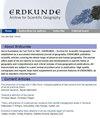: Evolution of alternative food networks in an old industrial region of Czechia
IF 1.1
4区 社会学
Q3 GEOGRAPHY
引用次数: 2
Abstract
The main aim of the article is to present a regional analysis of alternative food networks (AFNs) in the old industrial Moravia-Silesian Region in Czechia accompanied by an assessment of their extent, the basic characteristics of their constituents and evolution during the period between 2014-2018. Although a number of studies on AFNs have been published so far, a detailed geographical analysis of AFNs from the regions of Central and Eastern Europe is missing. This paper aims to fill this research gap by providing an in-depth regional analysis of AFNs' spatial distribution while covering both the production (farms integrated in AFNs) and consumption side of ‘local’ food (selected forms of its distribution). Based on selected publicly available databases, we revealed that the proportion of farms integrated in AFNs out of the total number of farms in the region was only 1.4% (or 5% of the total number of organic farms) in 2018. However, significant growth in the number of farms producing food for AFNs and on site farm sales was registered within the monitored period. Only one third of AFN farms can be considered as small farms (up to 10 ha). AFN farms dominantly focused on animal production and were concentrated mostly in the proximity of urban areas favourable for agriculture. The low number of identified farms might be explained, inter alia, by the higher intensity of food self-provisioning in the region.:捷克旧工业区替代食品网络的演变
本文的主要目的是对捷克旧工业摩拉维亚-西里西亚地区的替代食品网络(AFN)进行区域分析,并对其范围、组成部分的基本特征和2014-2018年期间的演变进行评估。尽管到目前为止已经发表了一些关于AFN的研究,但缺少对中欧和东欧地区AFN的详细地理分析。本文旨在通过对AFN的空间分布进行深入的区域分析来填补这一研究空白,同时涵盖“本地”食品的生产(整合在AFN中的农场)和消费(其分布的选定形式)。根据选定的公开数据库,我们发现,2018年,纳入AFN的农场在该地区农场总数中的比例仅为1.4%(或有机农场总数的5%)。然而,在监测期内,生产AFN食品的农场数量和现场农场销售显著增长。只有三分之一的AFN农场可以被视为小型农场(最多10公顷)。AFN农场主要集中在动物生产上,主要集中在有利于农业的城市地区附近。已确定的农场数量较少,除其他外,可解释为该地区粮食自给强度较高。
本文章由计算机程序翻译,如有差异,请以英文原文为准。
求助全文
约1分钟内获得全文
求助全文
来源期刊

Erdkunde
地学-自然地理
CiteScore
2.00
自引率
7.10%
发文量
17
审稿时长
>12 weeks
期刊介绍:
Since foundation by Carl Troll in 1947, ''ERDKUNDE – Archive for Scientific Geography'' has established as a successful international journal of geography. ERDKUNDE publishes scientific articles covering the whole range of physical and human geography. The journal offers state of the art reports on recent trends and developments in specific fields of geography and comprehensive and critical reviews of new geographical publications. All manuscripts are subject to a peer-review procedure prior to publication. High quality cartography and regular large sized supplements are prominent features of ERDKUNDE, as well as standard coloured figures.
 求助内容:
求助内容: 应助结果提醒方式:
应助结果提醒方式:


